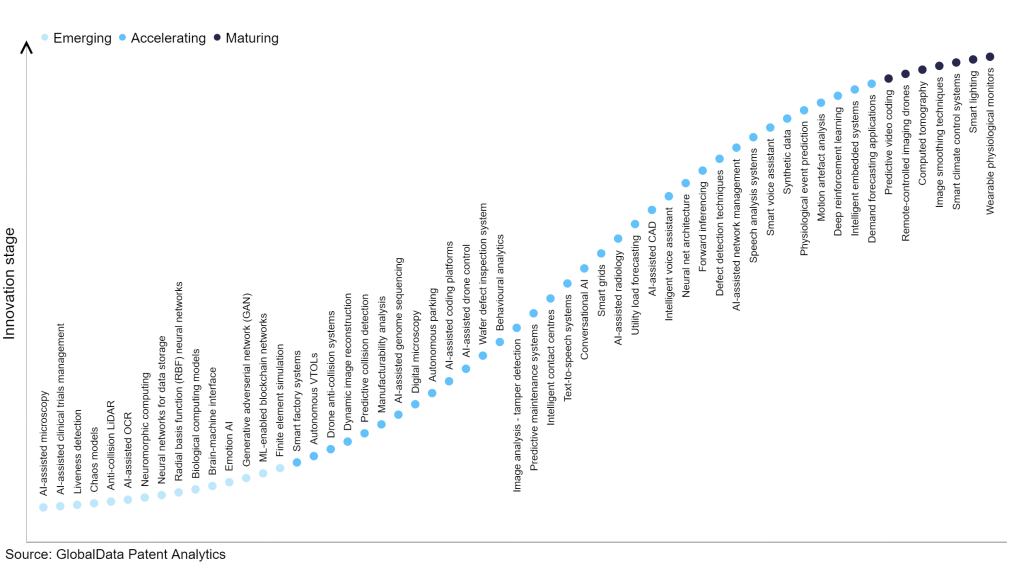The technology industry continues to be a hotbed of innovation, with activity driven by the increasing demand for high-quality images in various industries such as photography, entertainment, and medical imaging, the need for automated and efficient image enhancement solutions, and the continuous evolution of artificial intelligence (AI) algorithms and computing power, as well as growing importance of technologies such as deep learning models including convolutional neural networks (CNNs) and generative adversarial networks (GANs). These models learn from large datasets to intelligently analyse and reconstruct images for improved visual results. In the last three years alone, there have been over 3.6 million patents filed and granted in the technology industry, according to GlobalData’s report on Innovation in Artificial Intelligence: Image smoothing techniques. Buy the report here.
However, not all innovations are equal and nor do they follow a constant upward trend. Instead, their evolution takes the form of an S-shaped curve that reflects their typical lifecycle from early emergence to accelerating adoption, before finally stabilising and reaching maturity.
Identifying where a particular innovation is on this journey, especially those that are in the emerging and accelerating stages, is essential for understanding their current level of adoption and the likely future trajectory and impact they will have.
300+ innovations will shape the technology industry
According to GlobalData’s Technology Foresights, which plots the S-curve for the technology industry using innovation intensity models built on over 2.5 million patents, there are 300+ innovation areas that will shape the future of the industry.
Within the emerging innovation stage, finite element simulation, ML-enabled blockchain networks and generative adverserial network (GAN) are disruptive technologies that are in the early stages of application and should be tracked closely. Demand forecasting applications, intelligent embedded systems, and deep reinforcement learning are some of the accelerating innovation areas, where adoption has been steadily increasing. Among maturing innovation areas are wearable physiological monitors and smart lighting, which are now well established in the industry.
Innovation S-curve for artificial intelligence in the technology industry

Image smoothing techniques is a key innovation area in artificial intelligence
Image smoothing techniques refer to various methods employed to decrease or eliminate the presence of noise in an image. Typically, this is achieved through actions like blurring, averaging, or removing pixels from the image. Additionally, these techniques can effectively diminish the visibility of jagged edges within an image.
GlobalData’s analysis also uncovers the companies at the forefront of each innovation area and assesses the potential reach and impact of their patenting activity across different applications and geographies. According to GlobalData, there are 350 companies, spanning technology vendors, established technology companies, and up-and-coming start-ups engaged in the development and application of image smoothing techniques.
Key players in image smoothing techniques – a disruptive innovation in the technology industry
‘Application diversity’ measures the number of different applications identified for each relevant patent and broadly splits companies into either ‘niche’ or ‘diversified’ innovators.
‘Geographic reach’ refers to the number of different countries each relevant patent is registered in and reflects the breadth of geographic application intended, ranging from ‘global’ to ‘local’.
Patent volumes related to image smoothing techniques
Source: GlobalData Patent Analytics
Koninklijke Philips is a leading patent filer in image smoothing techniques. The company’s patents are aimed at invention describing a method that includes obtaining a set of energy dependent data generated from a spectral scan. The set of energy dependent data includes a sub-set of data corresponding to only contrast agent. The method also involves separating the sub-set of data from other data including non-contrast agent data.
The method further includes scaling the sub-set of data to change a concentration of the contrast agent and visually presenting the scaled sub-set of data.
Other prominent patent filers in the space include Siemens and Samsung Group.
By geographic reach, CDx Medical leads the pack, followed by Renault and GE Sensing & Inspection Technologies. In terms of application diversity, Great Circle Technologies holds the top position, followed by Ingeneus and Synaptics.
Image smoothing techniques have significantly advanced the field of image processing, enabling the enhancement and refinement of digital images. This technological progress involves the application of AI algorithms to remove noise, artifacts, and imperfections from images, resulting in smoother and visually appealing visuals.
To further understand how artificial intelligence is disrupting the technology industry, access GlobalData’s latest thematic research report on Artificial Intelligence (AI) – Thematic Intelligence.
Data Insights
From

The gold standard of business intelligence.
Blending expert knowledge with cutting-edge technology, GlobalData’s unrivalled proprietary data will enable you to decode what’s happening in your market. You can make better informed decisions and gain a future-proof advantage over your competitors.







